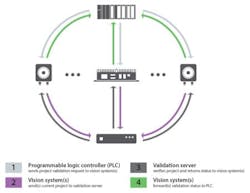Machine vision software: Growing and evolving with the market
Any company involved in machine vision for as long as Matrox Imagingknows that keeping up with the swift pace of the market is vital to sustainable success.
Since 1976, the machine vision software and hardware company has adapted to meet the ever-changing needs of customer and market needs. I recently had the chance to meet with several Matrox Imaging employees at their Dorval, QC, Canada headquarters, where we discussed—among other topics—their company’s approach to the proliferation of machine vision technology into everyday life. In fact, Jennie Kimpel, Manager, Corporate Marketing and Content at Matrox, said that the growth of machine vision is what the company is most excited about right now.
"Vision is getting into many more markets and applications at the moment and people are realizing what you can do with machine vision technologies," she said. "To a greater extent manufacturers and end-users are embracing it and learning about it, meaning vision is permeating more and more into mainstream applications."
One such novel application involves Matrox Imaging’s OCR software helping to digitize moon lander data. In 2015, NASA partnered with the University of Arizona to digitize more than 90,000 film images and data stored from 1960s-era Surveyor moon landers. The goal of this project was to create an archive for inclusion in the NASA Planetary Data System (PDS), a collection of data products from NASA planetary missions. >>> Learn more about this here.
With the growing adoption of machine vision, new users with little to no experience are entering the field and pressed for time to get up to speed. Realizing this, Matrox Imaging recently began offering online training services in an on-demand platform—Matrox Vision Academy—which was developed because of customer requests. This enables people to learn Matrox Imaging software without having to travel, and offers very specific instructions on how to accomplish certain tasks. >>> Learn more about this here.
"If the tools are there, but users don’t know how to use them, then they aren’t helpful," Kimpel explained. "These just-in-time instructional videos support users during initial software use, and even while evaluating our software, as well as throughout the vision development process. This training even remains helpful for people down the road, when they need a refresher on how to accomplish something."
This systematic support is integrated into Matrox Imaging technology. For example, Matrox Design Assistant software recently saw the addition of a new tool called the Project Change Validator (pictured). Available in version 5.1 of Design Assistant, the tool is a modification-proofing utility that ensures machine vision systems uphold inspection requirements following any project updates.
In terms of applications or technologies where Matrox Imaging sees growth or opportunity, Pierantonio Boriero, Director, Product Management, noted several.
"A major worldwide growth area is certainly automotive manufacturing," he said. "This is partly because we have an effective product in our Iris GTR smart camera that is compelling for automotive manufacturers, as these companies are more cost sensitive than they were in the past."
He continued, "3D is certainly another one, as this whole space is not yet mature. There is still a lot of work to be done there. It may fall off the news cycle, but there are still exciting developments being made."
In addition to these, he noted artificial intelligence, machine learning, and deep learning as other burgeoning markets. However, regarding the high levels of excitement around these technologies, he offered a word of caution.
"People tend to jump to conclusions or get too excited about these topics. The way we see it, these are complementary technologies, and not necessarily massive new game changers."
That said, the company clearly places a certain amount of importance on the technology, as they plan to productize machine learning early this year, along with introducing some capabilities for computational imaging.
In terms of the global vision market, Boriero provided an optimistic outlook: "We are growing, definitely growing. Vision is riding the coattails of automation in general, because people want to manufacture to higher-quality standards that their customers demand. Vision allows them to manufacture to these standards instead of relying on manual inspection."
View more information on Matrox Imaging.
Share your vision-related news by contacting James Carroll, Senior Web Editor, Vision Systems Design
To receive news like this in your inbox, click here.
Join our LinkedIn group | Like us on Facebook | Follow us on Twitter
About the Author

James Carroll
Former VSD Editor James Carroll joined the team 2013. Carroll covered machine vision and imaging from numerous angles, including application stories, industry news, market updates, and new products. In addition to writing and editing articles, Carroll managed the Innovators Awards program and webcasts.
